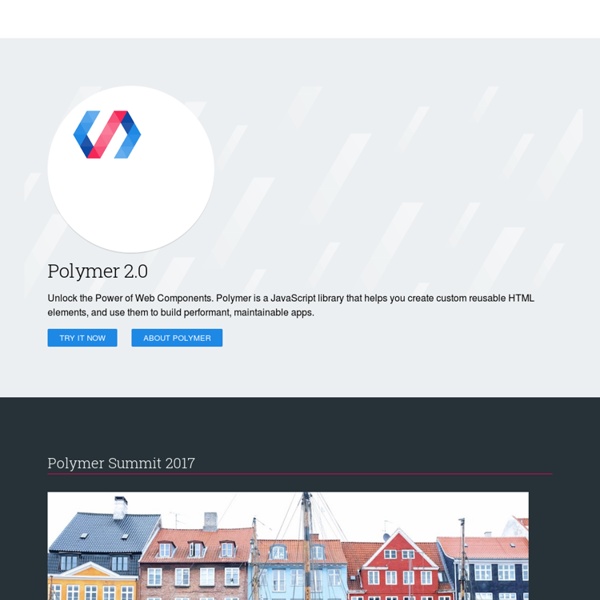



http://www.polymer-project.org/
Related: Lib (JavaScript)zip.js A JavaScript library to zip and unzip files zip.js provides a low-level API for writing and reading large zip files (up to 4GB with File writer API). zip-fs.js provides a high-level filesystem API. Lightning-fast RDF in JavaScript Node.js has spawned a new, asynchronous generation of tools. Asynchronous thinking is different from traditional stream processing: instead of actively waiting for data in program routines, you write logic that acts when data arrives. JavaScript is an ideal language for that, because callback functions are lightweight. I have written a parser for Turtle, an RDF serialisation format, that uses asynchrony for maximal performance. Representing triples The first important choice is the representation of triples (or quads, as I want to support graphs as well).
Jcrop - Deep Liquid Jcrop Home • Download • Manual • Examples Jcrop is the quick and easy way to add image cropping functionality to your web application. It combines the ease-of-use of a typical jQuery plugin with a powerful cross-platform DHTML cropping engine that is faithful to familiar desktop graphics applications. Feature Overview Attaches unobtrusively to images or block objects Supports aspect ratio locking Supports minSize/maxSize setting Callbacks for selection done, or while moving Keyboard support for nudging selection API features to create interactivity, including animation Support for CSS styling, now uses LESS Touch support for iOS, Android, etc Cross-platform Compatibility
50 JavaScript Libraries for Charts and Graphs How are you visualizing data in JavaScript? What is your favorite library for creating charts and graphs with JavaScript? I have been a long time fan of jqPlot for its open source approach, simplicity, examples, and great features. It performs well, it is used by many corporations, and it is built on top of jQuery. npm Documentation npm opens up an entire world of JavaScript talent for you and your team. It's the world's largest software registry, with approximately 3 billion downloads per week. The registry contains over 600,000 packages (building blocks of code). Open-source developers from every continent use npm to share and borrow packages, and many organizations use npm to manage private development as well. Here is a quick introduction to npm: npm consists of three distinct components:
GoJS Samples - HTML5 Canvas JavaScript graphics GoJS comes with the full JavaScript / HTML source to over 90 sample applications. Many of these samples show how to build classic diagram types like FlowCharts, workflows, Entity Relationship diagrams, State Charts, OrgCharts, class hierarchy trees, mindmaps social graphs, data visualization and planograms. Many others show off specific features like layout and using templates to define nodes. You can use these samples as the starting point for your application. Furthermore, the Getting Started Guide and Technical Introduction have hundreds of live example diagrams. See these samples live at GoJS Samples
React React est une librairie JavaScript, qui permet véritablement de révolutionner le développement des interfaces pour vos applications web La librairie bénéficie d’une grosse communauté et de nombreux modules très utiles sont maintenus dans les adèptes de React pour lui donner encore plus de puissance et de fonctionnalités. React, à quoi ça sert ? React permet de simplifier vos développements front-end en apportant une véritable touche de modernité lors de la création de vos interfaces. C’est une librairie qui permet de créer des Single Page App, en créant un DOM virtuel, dans lequel vous aller pouvoir agir très simplement en créant vos pages.
A slice of React, Clojurescript and Om Update 2014-01-16 Since I wrote this article, Om has undergone a few API changes. For consistency I have kept the original code in this article and put an updated version, using Om 0.1.6, that you can find here. Also note that you must use a compatible Clojurescript version (0.0-2138) for Om to work – this was something I missed which gave me really weird errors when using lookups on the cursors.
Meteor (framework) Un article de Wikipédia, l'encyclopédie libre. Pour les articles homonymes, voir Meteor. Meteor est un framework open-source de développement web en JavaScript basé sur Node.js. Le projet vise à créer un framework de « nouvelle génération » induisant un changement de paradigme notamment sur la manière de considérer les architectures client-serveur. Le projet est sorti en version stable 1.0 le 28 octobre 2014 Dans cette logique, Meteor inclut un système de gestion de base de données côté client, fonctionnalité originale du framework.
Home · tinkerpop/blueprints Wiki ReactJS vs Angular vs VueJS : Que choisir en 2018 ? ⋆ Ambient Formations Il existe de nombreuses technologies pour développer des applications web, mais laquelle est plus intéressante pour le projet que vous souhaitez mettre en place. Dans cet article, nous allons voir les avantages et inconvénients de chaque framework de frontend afin d’aider les professionnels ou les ingénieurs à choisir le meilleur pour leurs besoins de développement. Tendance du marché knrz/CSV.js Google I/O 2013 - Web Components in Action